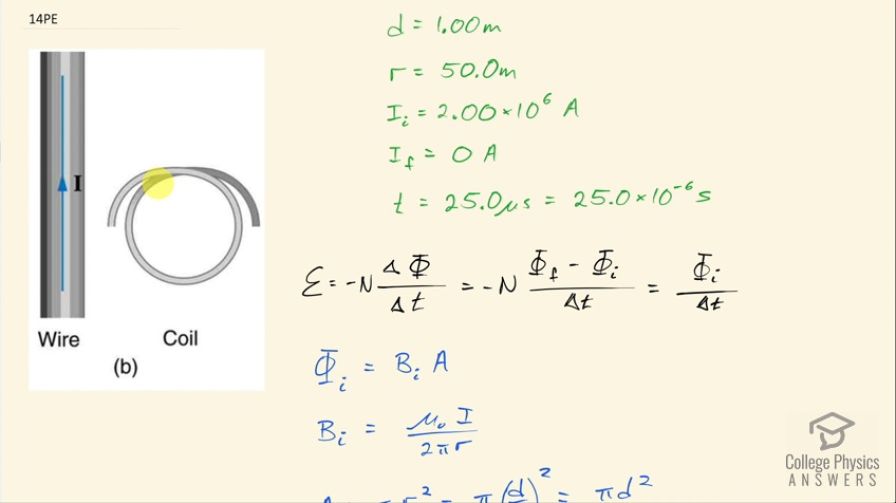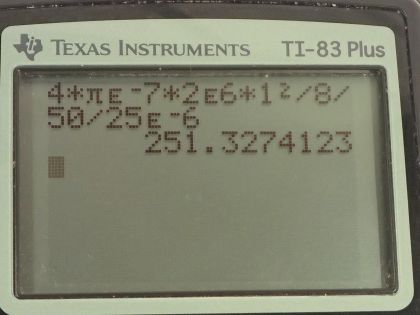Question
(a) A lightning bolt produces a rapidly varying magnetic field. If the bolt strikes the earth vertically and acts like a current in a long straight wire, it will induce a voltage in a loop aligned like that in Figure 23.57(b). What voltage is induced in a 1.00 m diameter loop 50.0 m from a lightning strike, if the current falls to zero in ? (b) Discuss circumstances under which such a voltage would produce noticeable consequences.
Final Answer
- Any generator or motor within 50.0 m of this lightning bolt might get destroyed. The coils typically have many turns of wire, resulting in even higher induced voltage, which would cauyse very high current. The high current would cause a lot of heat production very quickly (since ), and this heat would raise the temperature of the wires to their melting point.
Solution video
OpenStax College Physics, Chapter 23, Problem 14 (Problems & Exercises)

vote with a rating of
votes with an average rating of
.
Calculator Screenshots
Video Transcript
This is College Physics Answers with Shaun Dychko. We are told that a lightning bolt strikes 50.0 meters away from a coil that's oriented this way. So lightning bolt is vertical and the coil has its plane—also vertical— and the lightning bolt and the center of the coil are 50.0 meters apart so this is the distance r, 50.0 meters, and the lightning bolt has a current of 2.00 times 10 to the 6 amps and then it falls to a current of 0 within 25.0 microseconds, which is 25.0 times 10 to the minus 6 seconds. The diameter of this coil is 1.00 meter and so this distance here is 1.00 meter and obviously my drawing is not to scale but I think you get the idea this is d equals 1.00 meters and the question is what emf is induced in this coil? Now if we were to grab this lightning bolt— it's not a wire anymore, it's a lightning bolt— and if you were to grab this lightning bolt with your right hand, thumb pointing upwards say your fingers will be pointing into the page at the position of this loop and so the field lines are perpendicular to the plane of the loop and so they cause some flux and there's going to be a change in flux as the current reduces from 2.00 megaamps to 0 and that change in flux will cause an emf to be induced in the coil. So here's the formula for the induced emf: it's the number of turns in the coil, of which there's only 1 in this case times the change in flux divided by the amount of time it takes to make that change. So this change in flux is the final flux minus the initial flux and the final flux is zero because there's no current and therefore no magnetic field produced by that current after 25.0 microseconds... and N is 1 so if you make a substitution for both of those, you have this negative multiplied by this negative although negatives here are not super important because they just remind us that the induced emf creates a magnetic field that opposes the change in flux. Anyway we get the induced emf is the initial flux divided by time. So the initial flux is the initial magnetic field multiplied by area and we don't need to concern ourselves with the angle because the angle is 0 degrees in this case, the angle's measured between the magnetic field direction and the perpendicular to the plane both of which are pointing in and out of the page. So the initial magnetic field is that due to a current carrying wire— we can imagine this lightning bolt as a wire with some current I initial— we are multiplying that by the permeability of free space and dividing by 2π times the distance from the wire r. The area of the coil is π times the radius of the coil squared, L here for loop I think is what I was thinking of; I want to distinguish this r from this r here—they are different factors— so this radius of the loop then is half the diameter, which we are given, and we square that, we have π times diameter squared over 4. So then we substitute both of these things into our initial flux formula and we have the initial flux then is μ naughtI over 2π times distance from the wire times π times the diameter of the loop squared over 4 and this is μ naughtId squared over 8 times r. So that gets substituted into our formula for emf, which we do over here and so we have a fraction divided by a fraction and so I prefer to write the first thing multiplied by 1 over the denominator so this is the numerator Φ i multiplied by 1 over the change in time. So this is 4π times 10 to the minus 7 tesla meters per amp times 2.00 megaamps times 1.00 meters squared over 8 times 50.0 meters times 25.0 microseconds and this is 251 volts will be the induced emf in the coil. So part (b) asks us to discuss any practical consequences that might happen with a lightning bolt such as this; this tells us that any generator or motor within 50.0 meters of this lightning bolt might get destroyed because the coils typically have many turns in them and that will result in an even higher induced voltage because the formula for induced voltage is to multiply this fraction— which we figured out 251 volts— multiply that by the number of loops, the number of turns and in a generator or a motor, there are typically many turns and so the induced emf will be much higher than this in a real motor or generator and that higher induced voltage will cause a very high current and that current will cause a lot of heat and we have a formula for the rate at which heat will be produced: it's the current squared times the resistance and this exponent 2 tells us that the current matters a lot and so this would produce a lot of heat very quickly and that could melt the wires and destroy the motor or generator.
